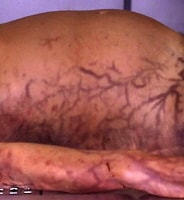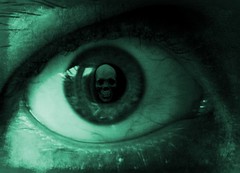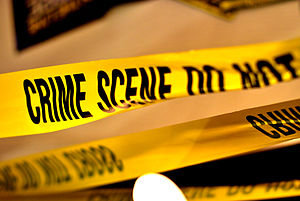______________________________________________________
| Grave (Photo credit: howzey) |
Excerpt - CHAIN LYNX
"Wilson wanted to make sure that he was long gone, and the body was in bad shape when it was found?”
Deep snorted. “Bad shape, that’s an understatement.”
"Wilson wanted to make sure that he was long gone, and the body was in bad shape when it was found?”
Deep snorted. “Bad shape, that’s an understatement.”
“How so?” I asked.
“It didn’t take the week to find the corpse. The heat in his motel room was on full blast, and they smelled the body from the lobby.”
“Oh, Gross!”
Deep waggled his brow. “I’m glad it wasn’t my job to pour him into a bag."
***
Here's a Video Quick Study (6:11) which humorously goes through the normal steps of what happens from death to interment.
Death is not a pretty sight. It doesn't resemble the Hollywood and television deaths or the deaths often portrayed in literature. There is a series of events that take place. Before we take a quick look at three aspect of decomposition -- algor, livor, and rigor -- let me just address three little sniggly bits.
1. Urine and Feces - Urine and feces will only leave the body if the bladder or bowl was full.
The sphincter muscles containing the waste matter relaxes, as do all of the muscles, no longer holding the
contents inside. If the person has been in the process of dying over many days then they probably have
not eaten or been hydrated and there is nothing to evacuate. If it is a sudden death, but the person has
just relieved themselves, they will not eliminate at death.
"The woman’s lifeless body collapsed like a heap of dirty laundry in front of the door. Urine pooled out from under her." ~ Missing Lynx
| Eye death (Photo credit: @Doug88888) |
holding the mouth/jaw shut requires engaged muscles. At
death the eyelids will be half open and the jaw will be open
and off-side. According to my daughter who is a telemetry
nurse, the mouth slacks and drifts to the side.
3. Frequently as death approaches the individual will go into a
coma or a coma-like state or they become agitated and
delusional. From speaking with nurses and hospice workers,
there is no last second confessional. They go into a state of
flux, and they expire.
Death is the cessation of all metabolic activity and functions.
1. Legal death can be reversed.
2. Biological death cannot be reversed.
WHAT DOES OCCUR POST MORTEM? How long has this person been dead?
* Breakdown happens because of the lack of body function and an increase in bacteria
(and other organisms such as bugs).
* How quickly the body breaks down is largely a function of temperature.
* The colder the temperature the slower the chemical changes that breakdown organic matter.
The cold temperatures also retard organisms such as bacteria and bugs
Video Quick Study (1:08) 5,000 yr old man found frozen in a glacier. The body is amazingly intact.
These changes overlap in time:
1 Algor Mortis -
NO! That's Al Gore. We're talking about ALGOR mortis when the dead body cools.
* The body loses 2 degrees C. in the first 2 hours and approximately
1 degree per hour after that. How cool the body gets depends on the ambient temperature.
* Glaister Equation.Link to formula This is most accurate in a temperature controlled environment.
* The fatter you are the more you store heat (faster decomposition)
* Temperature of the body at death also increases decomostion. Did they have a fever? Had they just run
a marathon?
* Clothing - More clothes trap more heat.
* Ambient temperature
Video Quick Study (5:09)
2. Rigor Mortis -
* Rigor mortis first appears approximately 1-2 hours after death.
* Progressive stiffening occurs for approximately 12 hours,
persists for approximately 12 hours, then
diminishes over the next 12 hours as tissues break down as a
result of autolysis and putrefaction.LINK
* Because rigor mortis is a chemical reaction to ATP and has to
do with shortening the muscle, it is
interesting to note that in someone who has been physically
active - fighting or running over a period of
time - the rigor mortis will set in more quickly.
Video Quick Study (0:48) the difference between cold stiffening and rigor mortis
Video Quick Study (3:10) talking about Michael Jackson and rigor mortis
3. Livor Mortis -
* There is no longer a functioning circulatory system so
the blood settles where gravity takes it and is seen
as purplish on the surface of the skin.
* If an object is laying below the body, such as a
weapon, it could show up as a lighter spot on the
tissue.
* Darker skin makes this harder to see.
* This takes place for about 8 hours. After 8 hours the
blood no longer moves even if the body is turned
over.
* Skin color might provide information about the cause
of death. For example cherry red is associated with
carbon monoxyde poisoning and pink is an indicator
for cyanide.
* Marbling may develop with the delineation of the
vasculature as a result of the reaction of hydrogen
sulfide produced by bacteria with hemoglobin from the
lysis of erythrocytes, as shown below. LINK
 Marbling outlines the vasculature in this decedent as the postmortem interval lengthens.
Marbling outlines the vasculature in this decedent as the postmortem interval lengthens.
4. As the body continues to decompose
* bacteria increases and produces a gas.
* The body might bloat from the gases esp. in the abdomen. It
can bloat to the point of bursting. This
bloating brings bodies to the surface of the water if the person
drowned or a body was dumped. According to Cookie, a
recovery diver who spoke to us at the WPA, the body will float
around the seventh day and will descend again once the fish,
birds, etc. who are eating the body poke a hole in the
tissue allowing the gases to escape.
3. Frequently as death approaches the individual will go into a
coma or a coma-like state or they become agitated and
delusional. From speaking with nurses and hospice workers,
there is no last second confessional. They go into a state of
flux, and they expire.
Death is the cessation of all metabolic activity and functions.
1. Legal death can be reversed.
2. Biological death cannot be reversed.
WHAT DOES OCCUR POST MORTEM? How long has this person been dead?
* Breakdown happens because of the lack of body function and an increase in bacteria
(and other organisms such as bugs).
* How quickly the body breaks down is largely a function of temperature.
* The colder the temperature the slower the chemical changes that breakdown organic matter.
The cold temperatures also retard organisms such as bacteria and bugs
Video Quick Study (1:08) 5,000 yr old man found frozen in a glacier. The body is amazingly intact.
These changes overlap in time:
1 Algor Mortis -
| Photo credit: Wikipedia) |
NO! That's Al Gore. We're talking about ALGOR mortis when the dead body cools.
* The body loses 2 degrees C. in the first 2 hours and approximately
1 degree per hour after that. How cool the body gets depends on the ambient temperature.
* Glaister Equation.Link to formula This is most accurate in a temperature controlled environment.
* The fatter you are the more you store heat (faster decomposition)
* Temperature of the body at death also increases decomostion. Did they have a fever? Had they just run
a marathon?
* Clothing - More clothes trap more heat.
* Ambient temperature
Video Quick Study (5:09)
2. Rigor Mortis -
* Rigor mortis first appears approximately 1-2 hours after death.
* Progressive stiffening occurs for approximately 12 hours,
persists for approximately 12 hours, then
diminishes over the next 12 hours as tissues break down as a
result of autolysis and putrefaction.LINK
* Because rigor mortis is a chemical reaction to ATP and has to
do with shortening the muscle, it is
interesting to note that in someone who has been physically
active - fighting or running over a period of
time - the rigor mortis will set in more quickly.
Video Quick Study (0:48) the difference between cold stiffening and rigor mortis
Video Quick Study (3:10) talking about Michael Jackson and rigor mortis
| Livor mortis Deutsch: Totenflecke (Photo credit: Wikipedia) |
* There is no longer a functioning circulatory system so
the blood settles where gravity takes it and is seen
as purplish on the surface of the skin.
* If an object is laying below the body, such as a
weapon, it could show up as a lighter spot on the
tissue.
* Darker skin makes this harder to see.
* This takes place for about 8 hours. After 8 hours the
blood no longer moves even if the body is turned
over.
* Skin color might provide information about the cause
of death. For example cherry red is associated with
carbon monoxyde poisoning and pink is an indicator
for cyanide.
* Marbling may develop with the delineation of the
vasculature as a result of the reaction of hydrogen
sulfide produced by bacteria with hemoglobin from the
lysis of erythrocytes, as shown below. LINK
 Marbling outlines the vasculature in this decedent as the postmortem interval lengthens.
Marbling outlines the vasculature in this decedent as the postmortem interval lengthens.4. As the body continues to decompose
* bacteria increases and produces a gas.
* The body might bloat from the gases esp. in the abdomen. It
can bloat to the point of bursting. This
bloating brings bodies to the surface of the water if the person
drowned or a body was dumped. According to Cookie, a
recovery diver who spoke to us at the WPA, the body will float
around the seventh day and will descend again once the fish,
birds, etc. who are eating the body poke a hole in the
tissue allowing the gases to escape.
See how this article influenced my plot lines in my novella MINE and my novel CHAOS IS COME AGAIN.
















+Face+2+Face+by+Mike+Roche.jpg)

.jpg)












